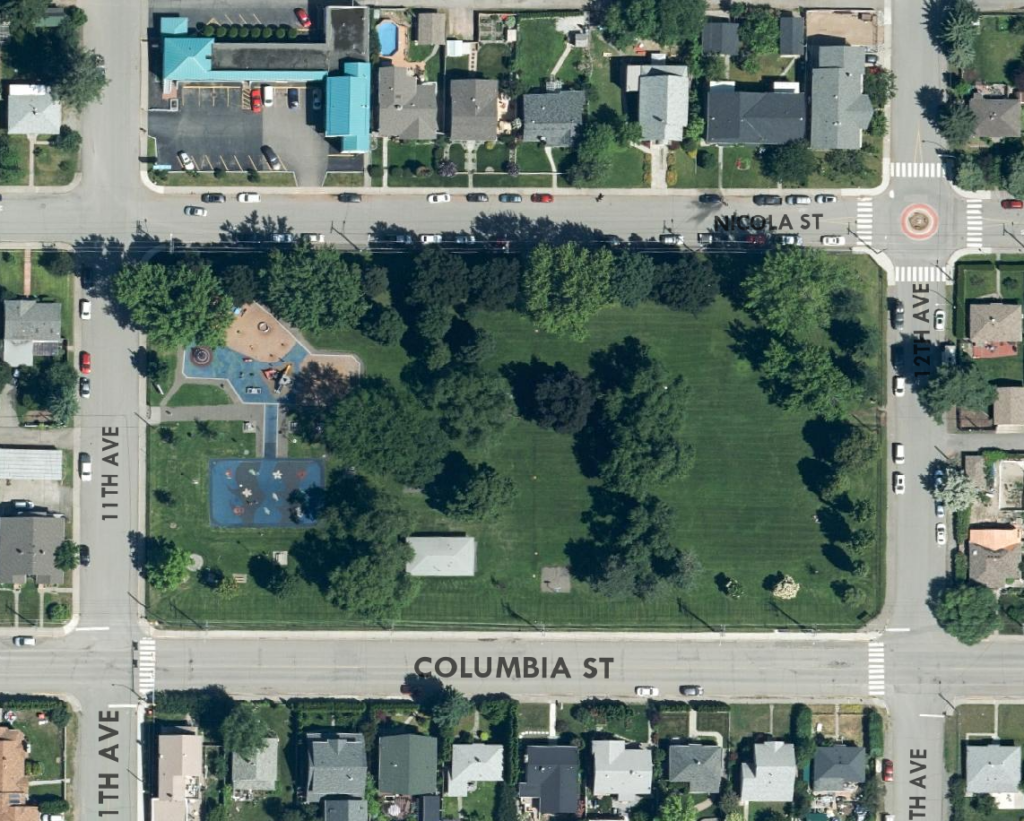6 Prince Charles Park
Ibekwe, Adaku
Introduction
Located right in the middle of the downtown residential area, Prince Charles Park is a relaxing piece of nature that provides recreational value for residents. With its proximity to homes primarily occupied by families and its well-maintained lawns and child-friendly amenities, it can be a notable deciding factor for families when compared to similar places without a park in proximity. Urban parks are one simple example of Green Infrastructure (GI) integrated with natural systems for the purpose of preserving natural systems but also providing services for human benefit (Ely and Pitman,2012). This paper attempts to assess the value of Prince Charles Park using revealed preference of land prices and discuss what is insufficient and other elements that might lead to a more accurate valuation.

Prince Charles Park
The Prince Charles Park is a serene, natural space that has been set aside for aesthetic purposes and recreational use in the city of Kamloops, British Columbia. It is nestled between 11th and 12th avenue, Nicola Street at its north, and Columbia at its south side. Located in an urban neighborhood downtown, it is surrounded by predominantly single-story residential buildings on all four sides. The park is largely flat and grassy with a variety of trees and shrubbery intertwined with walking trails for visitors. A few amenities have been added to the landscape over time to increase its recreational draw. Targeted largely at young children, these amenities enhance the park’s value while providing an incentive to preserve. A wading pool, playground sets, basketball hoop, public washroom, picnic tables, and open field that hosts various team sports and cultural events in warmer weather can all be found in its vicinity.

Methodology and results
The Prince Charles Park occupies an entire block with approximately 25 homes surrounding the park. Based on a city of Kamloops map, it sits on approximately 1.3 hectares of land. Following Sutton and Anderson’s hedonic pricing method, 20 properties were chosen from adjacent blocks and the current market land values were assessed. The average market price per hectare has then been applied to Prince Charles Park. Ecosystems services were estimated at a 5% return on investment in adherence to the Sutton study as well. Since the average value of equal-sized land in the residential blocks surrounding the park is $6.1 million per hectare (Table 1). This puts the land value of the park at roughly $8 million. The ecosystem services provided based on this value would be $396,500 per year. A more conservative assessment would be to use the ESVD database which prices ecosystem services at USD $100,000 per ha per year. At the current exchange rate, of 1.25 CND per 1 USD, the estimate would yield a value of $125,000 CND. This translates to $162,000 annually in ecosystems services (or a 2.1% annual yield). An older estimate was $6,661 ($11,470 in 2020 dollars) from Constanza’s ecosystem review. These variations emphasize the essential role of human, natural, and built capital interactions and how that shapes the flow of benefits from different green infrastructures (Sutton and Anderson, 2016).
Table 1: Descriptive statistics of 20 houses around Prince Charles Park
| Variable | Mean | StDev | Minimum | Q1 | Median | Q3 | Maximum |
|---|---|---|---|---|---|---|---|
| Land Value | 344,500 | 25,510 | 314,000 | 323,000 | 347,500 | 369,000 | 369,000 |
| Building Value | 236,315 | 74,166 | 117,000 | 180,000 | 223,000 | 273,500 | 393,000 |
| Year Built | 1946 | 2 | 1942 | 1946 | 1946 | 1948 | 1948 |
| Size (in Ha) | 0.06 | 0.14 | 0.14 | 0.06 | 0.06 | 0.06 | |
| Land value per Ha | 6,180,143 | 457,646 | 5,632,990 | 5,794,445 | 6,233,962 | 6,619,660 | 6,619,660 |
Discussion and conclusion
Acknowledging the diversity of benefits from urban parks is key in evaluating GI and must be integrated into the value mapping approach process (Kati et al,2016). This valuation supports that the flow of benefits from GI is greatly reliant on the spatial interactions of human, natural, social, and built capital. The major takeaway is existing frameworks of holding all other variables at constant as is often the economic norm, lead to disastrous undervaluation of GI. That said, the assumption being that the value of this park is at least equal to the revealed preferences of surrounding land price alone, still leaves space to underestimate the value of this park (Sutton and Anderson 2016). The values estimated in this paper only serve as a guide that will encourage nuanced frameworks and policies to be developed aimed at preserving Prince Charles Park and other green infrastructure in the Kamloops community.
References
Costanza, R., de Groot, R., Braat, L., Kubiszewski, I., Fioramonti, L., & Sutton, P. et al. (2017). Twenty years of ecosystem services: How far have we come and how far do we still need to go?. Ecosystem Services, 28, 1-16. https://doi.org/10.1016/j.ecoser.2017.09.008
ESVD. Esvd.net. (2022). Retrieved 13 March 2022, from https://www.esvd.net/esvd.
Kati, V., & Jari, N. (2016). Bottom-up thinking—Identifying socio-cultural values of ecosystem services in local blue green infrastructure planning in Helsinki, Finland. Land use policy, 50, 537-547. https://doi.org/10.1016/j.landusepol.2015.09.031
Sutton, P., & Anderson, S. (2016). Holistic valuation of urban ecosystem services in New York City’s Central Park. Ecosystem Services, 19, 87-91. https://doi.org/10.1016/j.ecoser.2016.04.003

